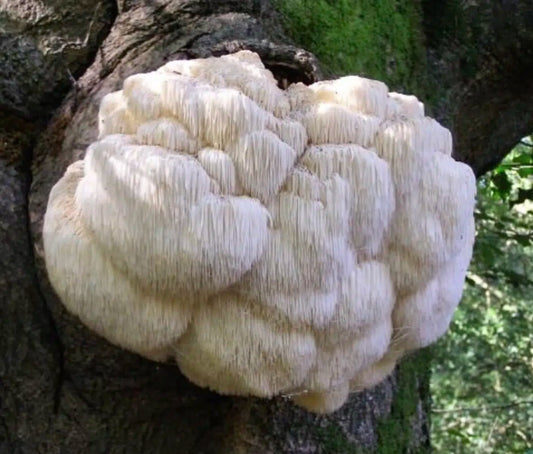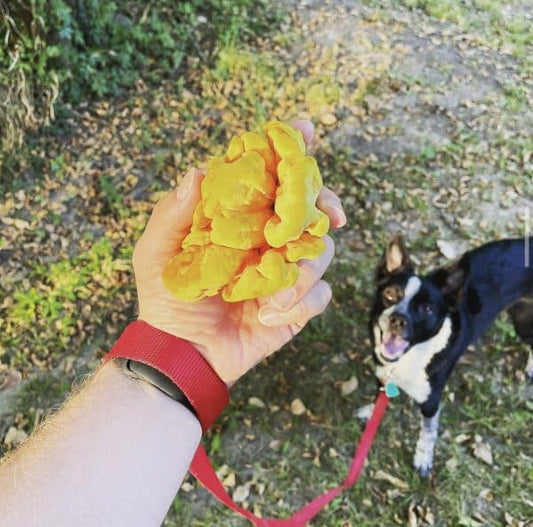When I first started growing mushrooms back in 2005, I used the PF Tek for growing mycelium and made a fruiting chamber out of a plastic tent armed with a humidifier, similar to a Martha Tent. Looking back, I wouldn’t consider it to be one of the best techniques for fruiting mushrooms, but it worked. I had plenty of mushrooms to harvest, as the humidity was constantly around 90% and there was sufficient air exchange. However, as I expanded my operation, I needed a better way to both grow mycelium and fruit mushrooms.
When I was still employing the PF Tek, I used the shotgun fruiting chamber with excellent results. It was so successful that I filled my apartment with shotgun fruiting chambers that were stacked to the ceiling. After I learned about using mushroom grow bags to grow mycelium, it made sense to switch over to the monotub fruiting chamber, as my yields were far higher with this method.
To this day, I still use the monotub fruiting chamber method, as it is one of the best techniques for fruiting mushrooms on an amateur scale. With my mushroom grow operation streamlined, my bottleneck was trying to dry all the mushrooms I was harvesting on a daily basis. I’ll leave that for another article, but it involved using the chemical desiccant calcium chloride, numerous fans blowing into plastic bins filled with mushrooms, and food dehydrators littered everywhere.
Let’s take a look at the best techniques for fruiting mushrooms on the amateur level. No matter what technique you choose, you will have plenty of mushrooms to harvest if you do it right.
What Are The Best Techniques For Fruiting Mushrooms
The best techniques for fruiting mushrooms include the shotgun fruiting chamber, monotub fruiting chamber, and the Martha tent.
Shotgun Mushroom Fruiting Technique
The shotgun mushroom fruiting technique was the second fruiting method I tried. It worked exceptionally well during the summer months when sunlight entered the window resulting in significant condensation inside the fruiting chamber. However, when winter came around, there wasn’t enough sunlight to induce passive condensation so I switched to another fruiting chamber that utilized a humidifier.
The nice thing about the basic shotgun fruiting technique is that it doesn’t require any power input, as all the moisture is already contained within the fruiting chamber, causing high levels of humidity if condensation is induced by sunlight.
Additionally, the small holes throughout the sides of the plastic bin enable air exchange, although the bin should still be aired out with the cover at least twice a day. Airing out the bin will ensure that carbon dioxide levels don’t build up, forcing the mushrooms to stretch for oxygen.
Materials You Will Need To Construct The Basic Shotgun Fruiting Chamber
-
A plastic, transparent bin with a snap-on cover
-
Perlite

Since only two materials are required for the shotgun fruiting chamber, anyone on a budget should construct this option before other, more expensive options.
Take the transparent plastic bin and drill small holes equidistant around the upper 2/3 portion of the bin. Something like quarter-inch holes is perfect so use a quarter-inch drill bit to make the bin look like it was hit by a shotgun birdshot. Leave the bottom third of the bin intact, as it will have to hold the perlite saturated in water.
Adding Perlite To the Shotgun Fruiting Chamber

Now, fill up the bottom quarter of the bin with water and then add enough perlite to settle just above the water line. Perlite is extremely dusty so it is best to have the water already in the bin so it absorbs some of that dust. Ideally, when doing this, pour it in slowly, in an outdoor location, and use a mask.
At this point, the perlite should be completely saturated in water, but there shouldn’t be puddles of water at the top. The wet perlite gives the mycelium-rich substrate a floor where it can sit throughout the fruiting process.
When I originally started using the shotgun fruiting chamber, I was still using mycelium cakes made from the PF Tek. I simply pulled the cakes out of the Mason jars when they were fully colonized and set them onto the perlite, filling up each bin with 12 cakes.
At this point, you can spray the sides and cover of the plastic bin with water to jump-start the humidification, but simply snapping on the cover and leaving it exposed to sunlight, ideally in a southward-facing room, will quickly raise the level of the humidity over 75% and keep it there.
As stated before, fan out the fruiting chamber twice a day and you will quickly notice primordia begin to develop into full-grown mushrooms. Harvest the mushrooms with an X-Acto knife so you don’t damage newly forming mushrooms and either eat the mushrooms or store them for later use.
Using the shotgun fruiting chamber is as easy as it gets, as it doesn’t require electricity or expensive materials. If humidity levels would have remained high throughout the winter, I would have continued using this method, but since I had to increase humidity, I moved on to using an advanced version of the monotub fruiting chamber that I will describe next.
If you want to stick with the shotgun fruiting chamber, but don’t have enough humidity, you can just route in mist from a reptile fogger or ultrasonic humidifier into the bin. On the other hand, if you are looking for a better technique entirely that will reduce contamination, in addition to maintaining high humidity levels, move on to the monotub fruiting chamber.
Monotub Mushroom Fruiting Chamber
The monotub fruiting chamber is the main option that amateur growers use today, as it reduces incidences of contamination while maximizing all environmental factors conducive to growing mushrooms. I am going to describe both the most basic setup and the advanced monotub fruiting chamber with all the bells and whistles.
The monotub fruiting chamber was a better option for me when I moved over to using mushroom grow bags for growing mycelium instead of Mason jars. Since there was significantly more material in the grow bags than in the Mason jars, I was able to fill out the entire bottom of the bin with the mycelium-rich substrate, greatly increasing fruiting surface area and harvest.
Basic Monotub Fruiting Chamber
Just like the shotgun fruiting chamber, the monotub fruiting chamber uses a transparent plastic bin with a snap-on cover. However, the monotub fruiting chamber utilizes air filters for air exchange, rather than wide open holes like the shotgun fruiting chamber.
Materials You Will Need To Construct The Basic Monotub Fruiting Chamber
- A plastic, transparent bin with a snap-on cover
- Polyfill
- Black paint
- Duck tape
- Door handle drill bit
Modifying The Plastic Bin
The basic monotub fruiting chamber is relatively easy to make. First, take the plastic bin and drill two holes in each long side and one hole in each short side using a door handle drill bit. To reduce the probability of cracking the plastic bin, place a wood block on the inside of the bin and drill the holes from the outside.
After all the air holes are drilled out, sand down the holes so they aren’t sharp and add a ball of polyfill into each hole, securing it with duct tape on the inside and outside of the bin. There should be no gaps that air can pass through without passing through the filter. The polyfill filter reduces potential contamination, as air exchange takes place while keeping contaminants out.
After filling all six holes with polyfill, paint the bottom and the lower 2 inches of the bin with black paint. The reason for this is so no light can reach the sides and bottom of the bin where the mycelium is located. If primordia forms in these areas, it is a waste of limited resources, as it won’t be able to develop into full-grown mushrooms.
The Monotub Fruiting Chamber In Action
When you are ready to use the monotub fruiting chamber, use alcohol to sterilize the inside of the bin and add the mycelium-rich substrate to the bottom. Then, spray the sides and top of the monotub fruiting chamber with water and snap on the cover. With this basic setup, you will have to spray the inside of the monotub fruiting chamber multiple times a day to maintain relatively high levels of humidity.
Advanced Monotub Fruiting Technique
If you don’t want to be married to your monotub fruiting chamber, it is best to automate humidity levels by using a reptile fogger or ultrasonic humidifier. Additionally, using a computer fan improves air exchange, resulting in higher-quality mushrooms. If for some reason your fruiting chamber is set up in a room that receives no light, you can add an LED light to the inside cover of the monotub to induce fruiting.
Automate Humidity
Since I didn’t want to spray down the bin multiple times a day and hand spraying the bin wouldn’t maintain optimal humidity levels during the dry winter months, I used a reptile fogger to maintain humidity. I cut a small hole in the bin and fitted a tube that ran mist from the reptile fogger into the bin. The reptile fogger was connected to a humidity sensor that would shut it off when the monotub reached 90% humidity and turn it back on when humidity levels dropped below 75%.
Optimizing Air Exchange
To optimize air exchange through the polyfill air filters, add a computer fan so carbon dioxide is quickly pushed out of the monotub, allowing mushrooms to breathe in the rich oxygen they desperately need for optimal growth. Simply cut out a hole big enough to fit a computer fan, install it so it blows air out of the bin, and duct tape it into the monotub. Leave the computer fan on 24 hours a day.
Growing Mushrooms In The Advanced Monotub Fruiting Chamber

The monotub fruiting chamber is the perfect match when using mushroom grow bags to grow mycelium. After the mycelium completely encompasses the rye berries or some other substrate in the mushroom grow bags, mix it with sterilized coco coir in the monotub fruiting chamber. Now cover the monotub and initiate humidity and airflow automation.
As soon as mycelium grows throughout the coco coir, either allow it to fruit or better yet, cover it with a layer of damp peat moss, a process called casing. After the mycelium grows through the peat moss, primordia will start forming. These mushrooms will quickly mature and be ready for harvest.
With the advanced monotub technique, mushrooms grow throughout the entire bottom of the bin which equates to bigger harvests and more flushes. After casing the substrate in the automated monotub fruiting chamber, I spend my time watching cat videos until it is time to harvest mushrooms.
Martha Tent Mushroom Fruiting Chamber
The Martha tent fruiting chamber is another viable option to grow relatively large quantities of mushrooms in a limited area. A Martha Tent is simply a series of shelves that has a plastic covering over the entire structure to maintain a high humidity level.
Materials You Will Need To Construct The Martha Tent
- A rack or metal shelving
- Transparent plastic tent with a zipper, something like a greenhouse tent
- Ultrasonic humidifier or reptile fogger
- Humidity Sensor
- Exhaust fan
Making a Martha Tent
After placing a greenhouse tent or a transparent, plastic tent with a zipper over metal shelving or racks, connect a hose or duct from an ultrasonic humidifier or a reptile fogger that will blow mist into the Martha tent. Another option is to simply leave the humidifier at the bottom of the Martha Tent. Connect the humidifier to a humidity sensor so it turns on when the humidity drops below 75% and turns off when humidity exceeds 90%. Place the humidity sensor at the top of the tent.
Install an exhaust fan at the top of the Martha tent to blow air out so carbon dioxide doesn’t build up in the chamber. Below the tent, place a drip tray, as excess humidity will end up puddling on the floor.
All sensitive electrical components should be placed outside the Martha tent.
The Best Techniques For Fruiting Mushrooms
The shotgun fruiting chamber, monotub fruiting chamber, and Martha tent are the best techniques for fruiting mushrooms for beginners and even advanced growers. Since it is easy to set up these fruiting chambers anywhere in your house, it isn’t necessary to convert an entire room into a fruiting chamber.
If you are looking to grow high quantities of mushrooms, build more Martha tents, or stack monotub fruiting chambers and shotgun fruiting chambers on top of each other. Pretty soon you won’t know what to do with all the mushrooms you are growing. Trust me, this is a good problem to have.
If you want to start experimenting with growing mushrooms, purchase a mushroom grow kit from us and allow us to guide you on your adventure.



